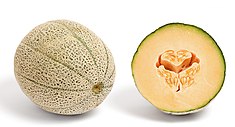| Cantaloupe | |
|---|---|
 European cantaloupe (true cantaloupe) | |
| Genus | Cucumis |
| Species | C. melo |
| Subspecies | C. melo subsp. melo |
| Cultivar group | Cantalupensis Group (incorporating Reticulatus Group)[1] |

The cantaloupe (/ˈkæntəloʊp/ KAN-tə-lohp) is a type of true melon (Cucumis melo) from the family Cucurbitaceae. Originally, cantaloupe referred only to the non-netted, orange-fleshed melons of Europe, but today may refer to any orange-fleshed melon of the C. melo species,[2] including the netted muskmelon which is called cantaloupe in North America, rockmelon in Australia and New Zealand, and spanspek in Southern Africa. Cantaloupes range in mass from 0.5 to 5 kilograms (1 to 11 lb).
Etymology and origin
The name cantaloupe was derived in the 18th century via French cantaloup from The Cantus Region of Italian Cantalupo, which was formerly a papal county seat near Rome, after the fruit was introduced there from Armenia.[3] It was first mentioned in English literature in 1739.[2] The cantaloupe most likely originated in a region from South Asia to Africa.[2] It was later introduced to Europe, and around 1890, became a commercial crop in the United States.[2]
Melon derived from use in Old French as meloun during the 13th century, and from Medieval Latin melonem, a kind of pumpkin.[4] It was among the first plants to be domesticated and cultivated.[4]
The South African English name spanspek dates back at least as far as 18th-century Dutch Suriname: J. van Donselaar wrote in 1770, "Spaansch-spek is the name for the form that grows in Suriname which, because of its thick skin and little flesh, is less consumed."[5] A common etymology involves the Spanish-born Juana María de los Dolores de León Smith, who ate canteloupe for breakfast while her husband and 19th-century governor of Cape Colony, Sir Harry Smith, ate bacon and eggs; the fruit was termed Spanish bacon (Afrikaans Spaanse spek) by locals as a result.[6][7] However, the term had been in use well before that point.
Types
 Cantaloupe in cross-section | |
| Nutritional value per 100 g (3.5 oz) | |
|---|---|
| Energy | 141 kJ (34 kcal) |
8.16 g | |
| Sugars | 7.86 g |
| Dietary fiber | 0.9 g |
0.18 g | |
0.82 g | |
| Vitamins | Quantity %DV† |
| Vitamin A equiv. | 26% 232 μg26% 2780 μg32 μg |
| Thiamine (B1) | 4% 0.049 mg |
| Riboflavin (B2) | 2% 0.027 mg |
| Niacin (B3) | 4% 0.694 mg |
| Pantothenic acid (B5) | 2% 0.085 mg |
| Vitamin B6 | 2% 0.04 mg |
| Folate (B9) | 4% 14 μg |
| Vitamin C | 12% 10.9 mg |
| Vitamin K | 2% 2.7 μg |
| Minerals | Quantity %DV† |
| Calcium | 1% 9 mg |
| Iron | 2% 0.38 mg |
| Magnesium | 3% 13 mg |
| Manganese | 2% 0.046 mg |
| Phosphorus | 1% 17 mg |
| Potassium | 5% 157 mg |
| Sodium | 1% 30 mg |
| Zinc | 4% 0.44 mg |
| Other constituents | Quantity |
| Water | 90.2 g |
| †Percentages estimated using US recommendations for adults,[8] except for potassium, which is estimated based on expert recommendation from the National Academies.[9] | |
The European cantaloupe or true cantaloupe, C. melo var. cantalupensis, is lightly ribbed with a sweet and flavorful flesh and a gray-green skin that looks quite different from that of the North American cantaloupe.[2]
The North American cantaloupe or muskmelon, C. melo var. reticulatus, common in the United States, Mexico, and some parts of Canada, is a different variety of C. melo, a melon with a reticulated ("net-like") peel.[2] It is a round melon with firm, orange, moderately sweet flesh.
Production
In 2016, global production of melons, including cantaloupes, totaled 31.2 million tons, with China accounting for 51% of the world total (15.9 million tons).[10] Other significant countries growing cantaloupe were Turkey, Iran, Egypt, and India producing 1 to 1.9 million tons, respectively.[10]
California grows 75% of the cantaloupes in the US.[11]
Uses
Culinary
Cantaloupe is normally eaten as a fresh fruit, as a salad, or as a dessert with ice cream or custard. Melon pieces wrapped in prosciutto are a familiar antipasto. The seeds are edible and may be dried for use as a snack.
Because the surface of a cantaloupe can contain harmful bacteria—in particular, Salmonella[12]—it is recommended that a melon be washed and scrubbed thoroughly before cutting and consumption to prevent risk of Salmonella or other bacterial pathogens.[13]
A moldy cantaloupe in a Peoria, Illinois, market in 1943 was found to contain the highest yielding strain of mold for penicillin production, after a worldwide search.[14][15]
Nutrition
Raw cantaloupe is 90% water, 8% carbohydrates, 0.8% protein and 0.2% fat (table). In a reference amount of 100 grams (3.5 oz), raw cantaloupe supplies 140 kJ (34 kcal) of food energy, and is a rich source (20% or more of the Daily Value, DV) of vitamin A (29% DV) and a moderate source of vitamin C (13% DV). Other micronutrients are in negligible amounts (less than 10% DV) (table).
See also
References
External links
 Media related to Cucumis melo cantaloupe group at Wikimedia Commons
Media related to Cucumis melo cantaloupe group at Wikimedia Commons- Sorting Cucumis names– Multilingual multiscript plant name database
